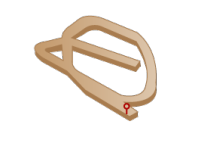Race type - Mixed
Cheltenham
Course details
Cheltenham is the undoubted home of National Hunt (jumps) racing in Britain & Ireland and its showpiece event is the Cheltenham Festival, held over four days in March. Outside the Festival, 'The Showcase' meeting in October and 'The Open' meeting in November are not far behind the festival itself in terms of competitiveness and excitement.
There are actually three courses in one at Cheltenham: the Old Course, New Course and Cross-Country Course. The golden rule is concentrate on those horses with previous form at Cheltenham as not all horses take to the unique track.

GUIDE - For Racecourse
Left-handed, Heart-shaped complex of Old and New park courses. Both are undulating, 1m4f round and end with a testing uphill finish.
Cheltenham is the undoubted 'home' of National Hunt racing in Great Britain and Ireland. Situated in the lee of the Cotswold Hills (Cleeve Hill overlooks it), it provides a stunning setting for the sport's most prestigious races and for four days in March the nearby town is besieged by racegoers attending the Cheltenham Festival, the most important of all the racing festivals. This comprises of 27 races, including the Gold Cup, Champion Hurdle, Champion Chase, and crowds of over 50,000+ are the norm with every vantage point taken.
Principal Races:
It's every owners dream to have a winner at Cheltenham so every race run here has added significance. These days the entire National Hunt season seems to be geared towards the Festival, which takes place over four days in March. The four championship races are the Champion Hurdle (for 2m hurdlers), Champion Chase (2m chasers), World Hurdle (staying hurdlers) and the Gold Cup, which is is run over 3m2f and determines the best staying chaser in the land. The other 23 races are all 'championship' races of sorts, each being framed with a particular type of horse in mind. For example, the Triumph Hurdle caters for the top juvenile hurdlers, while there is even a race over the unique cross-country course.
Outside the festival, 'The Showcase' meeting in October gives racing fans an early look at the season's potential champions, while 'The Open' meeting in November now closely rivals the Festival for competitiveness and excitement. Paddy Power have sponsored the meeting for the last few years and have lent their name to the Gold Cup, which is run on the Saturday and is seen as the season's first big betting race. Martin Pipe made the race his own, winning it eight times, and his son David got off the mark with the well-backed Great Endeavour in 2011. Like most winners, Great Endeavour tried to follow up in the big handicap chase at 'The International' meeting held here in early December, but could only finish 11th after being badly hampered three out. That meeting also stages a valuable hurdle and the winner is nearly always a Champion Hurdle aspirant. Further Festival clues can be gleaned from 'Festival Trials Day', which takes place at the end of January.

Course Characteristics:
There are actually three courses in one at Cheltenham: the Old Course, New Course and Cross-Country Course, which traverses the middle of the track and is a figure of eight with an assortment of obstacles. The Old Course is used in October, November and on the first two days of the Festival, while the Cross Country Course is used for one race at each of the Open, International and Festival meetings. Both the Old and New are severely undulating and all three courses can be described as idiosyncratic, which encourages course specialists.
The Old Course is less galloping than the New Course but both have a long up-hill run-in in common and this places a distinct emphasis on stamina. Many a horse has looked home and hosed after jumping the last only to be found out by the stiff gradient and, indeed, in-running punters you would have made a good profit by laying off such horses at short odds, more so here than at most other meetings. But the golden rule is concentrate on those horses with previous form at Cheltenham as not all horses take to the unique track.
Top Trainers:
Paul Nicholls leads the way in all meetings here with 62 winners over the past five seasons from 416 runners (15%), and he has a reputation for landing the big Saturday races at the track. Not far behind is Nicky Henderson on 50 winners (from 359 runners, 14%), and then there is a gap back to Philip Hobbs, David Pipe and Nigel Twiston Davies. All five trainers' runners at the four-day Festival need respecting but the mass invasion from Ireland usually means the 27 races are split, and Willie Mullins is by far their most dominant trainer. He has sent out a phenomenal 33 festival winners so far in his career, with his best haul coming in 2013 with five. He has plenty of runners and his record in handicaps is poor, so it's the championship races where punters should be following him. Other notable Irish trainers who should always be respected at the festival are Noel Meade, Mouse Morris and Gordon Elliott.
Top Jockeys:
Barry Geraghty has overtaken Ruby Walsh as top jockey here over the past five seasons with 46 of his 245 rides (19%) obliging, although the latter can boast a better strike rate of 23% (42 wins from 184 rides). Neither would have yielded a profit by backing their mounts blind so a selective approach is required. The top British jockey is Richard Johnson with 37 winners from 243 rides (15%), closely followed by the legend that is Tony McCoy (31-210, 15%), who will be retiring at the end of the 2014/15 season. Less well known jockeys who would have made backers a profit to level-stakes are: Bryan Cooper, Mr Derek O'Connor (top Irish amateur), Ms K Walsh and Richie McLernon.